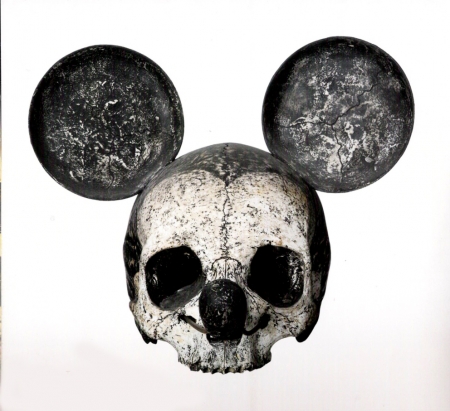
Nicholas Rubinstein
“…men have less scruple in offending
one who is beloved than one who is feared, for love is preserved by the link of
obligation which, owing to the baseness of men, is broken at every opportunity
for their advantage; but fear preserves you by a dread of punishment
which never fails”
Machiavelli
“The endgame can never be played with the same conviction with which it was played when the game was being invented.”
Donald Kuspit
“In other words, it is not so much a question as to whether we are able to cure a patient, whether we can or not, but whether we should or not.”
Ernest Becker
The *fake news* speech Obama delivered recently, and the accompanying articles in those organs of Imperial rule, the NY Times and Washington Post, are only the latest, albeit most extreme, expressions of criminalizing dissent that began, really, if one wants to go all the way back, with the Immigration Acts of 1903 and 1917 and the Espionage and Sedition Act also of 1917.
Geoffrey Skoll wrote…
“The Smith Act, also known as the Alien Registration Act of 1940,
made political beliefs and activities conditions of immigration, and made
advocacy of overthrowing the government a crime (Goldstein 1978; Preston
1963). These laws, although couched in the apparently objective language of
the Anglo-American legal tradition, aimed at suppression of what authorities
deemed dangerous ideas held by dangerous people, particularly the recent
immigrants from Eastern Europe and Black migrants from the South to the
North. The confluence of politics, political beliefs, and status identities did
not just apply to nationalities or ethnic groups, it also applied to salient racial
categories in America.”
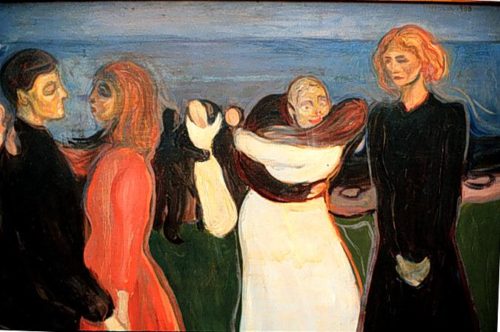
Edvard Munch (Dance of Life, 1899, detail).
All of these government legislative acts were expressions of ruling class anxiety about the masses getting the wrong ideas into their heads. The attacks on organized labor in the summer of 1919 included a ramped up racial element as the black migration north was creating worry in the white worker, and acute worry in the guardians of Capital. Following WW2 the anti communism that can be traced back to the 1860s was re-branded in a new hyper jingoistic paranoia with the McCarthy witch hunts. Then in the 1960s the FBI began pro actively targeting black radicals. But cutting across all of these phases of manufacturing fear was a growing emphasis on exploiting social anxiety. People were encouraged to distrust each other. To fear their neighbor. The post 9/11 propaganda, while certainly pushing an Islamophobic sentiment, has also ratcheted up a generalized fear as a normal and even salutary psychological state. The haute bourgeoisie have been the most responsive to this latest *fake news* ploy by the government. Because firstly, it is Obama saying it, and second because it flatters their well marketed sense of self. That self is the new rational man, the sober realistic individual. And nobody has delivered that sense of sobriety as well as Obama. In the coming decades, if any of us survive, Obama will be looked back on as the most perfect marketing creation in history. (I suspect Michelle Obama may well be a Democratic Party candidate before too long).
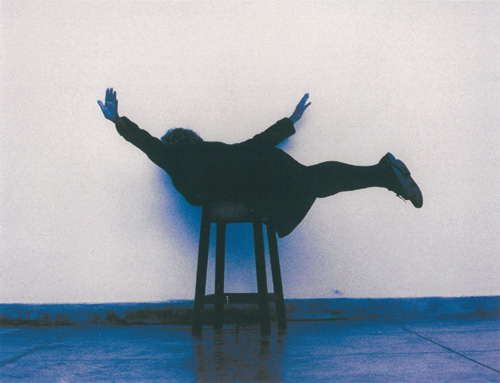
Helena Almeida
The average white liberals response to Fidel Castro’s death speaks to this idea of propagandized white individuality. Castro’s support of African independence, his solidarity against apartheid and the achievements domestically in the removal of illiteracy in Cuba, and a world class health care system are mostly ignored. And part of this is linked to the underreported rightward lurch of the Hollywood entertainment industry. And one part of this rightward lurch was to re-configure the white supremacist backdrop to American social history. The noted *Southern Strategy* that Nixon employed was to later morph into a more stealth racism that sought to present itself as a progressive integrationist trope. And indeed on certain levels this was true. There was a certain clear progress. But the backdrop remained white. Hollywood has never really capitulated its white supremacist model for story telling. And by the time of Obama this deep racist history was simply omitted. The omission was not total, of course. But the ‘white savior’ theme did become pronounced, but even that was not the real story. The severity of the U.S. political class’ racism was muted — films on J. Edgar Hoover smoothed over the virulent hatred Hoover had for blacks and latinos. And the viciousness of U.S. police racism and a deeply racist judicial system were all but ignored. In a sense this was Hollywood doing a ‘limited hang out’ on white supremacism. The very phrase ‘white supremacism’ was reserved for hood wearing Klansmen and Aryan nationalists. The deeper racial resentments of institutional America were invisible in media and in Hollywood film. And increasingly along side this was a gradual removal of working class voices. Today Hollywood is the provenance of the very affluent white bourgeoise. Class is acutely segregated in Hollywood film. The most honest depiction of working class America in Hollywood is likely The Simpsons. A show like Orange is the New Black can serve as the default and accepted position of whiteness in Hollywood. And with Obama as President, the affluent educated classes can congratulate themselves on their progressive entertainment products as well as point to the fact that a post racial America must exist because, after all, the President himself is black.
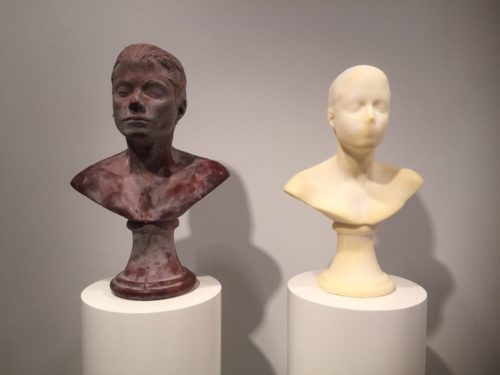
Janine Antoni
The post Vietnam policies of the ruling class was to merge Communists, blacks, and later Muslims — along with hippies and anything that smacked of anti-establishment values into one basket. All of it was to become associated with anti-Americanism. The now volunteer military was to be very consciously fawned over and this militarized hyper patriotism theme was seen in everything from Hollywood film to sporting events and journalism. And while the right wing outlets like FOX were obvious targets of derision for liberals, the fact is that the liberal media (CNN and MSNBC et al) were actually just as jingoistic. With the advent of 9/11 the entire apparatus of propaganda in the U.S. merged into a single message: the war on terror must be fought. And it must be won. And that war is a war on the global south. The side bar effects included an exaggerated coverage of any kind of social transgression or crime. From sexual predators, to high crime inner cities and black gangs, to immigration threats and even super viruses lurking at the gates to the white world. Fortress America was born. And even the weather became criminalized (Killer storms, etc). Drug addicts and the homeless were targets. This marked a resurgent Puritanism that saw that which waited at the gates to the Fortress as being not only dangerous and violent, but also unclean. The rise of health care concerns with allergies was just one by product of this. I knew people who claimed tests had proven they had an allergy to trees. Alongside this ran the dramatic spike in the use of psychoactive drugs. The white class were taking industrial level amounts of serotonin reuptake inhibitors (SSRIs). The culture of anti depressants became an almost fashion in the white professional class. By 1990 over 650,000 prescriptions were being written for SSRIs. In 2009 it was estimated that close to 15% of adults took SSRIs, and that figure does not include those under the age of twenty. And there are increasing numbers of teenagers who are prescribed anti depressants. There are currently studies underway to see if triple reuptake versions might be even more effective. But effective at what, exactly? The notion of depression itself is very opaque and a society that is this depressed might well want to examine what they mean when they say they are depressed. But to ask that, of course, means asking a whole lot of other questions. In the society of manufactured fears the notion of depression is mitigated by an anxiety that rises out of a completely mystified idea of the social good. Of what society itself means. What meaning means.
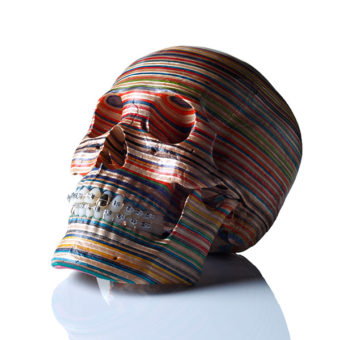
Haroshi
The postmodern critique of modernism always included the idea of modernism as totalizing — and that it propagated the metanarratives of the white bourgeoisie. This critique was both right and not right. The ‘not right’ part is a lot of what I have tried to write about in this blog. The modernists of the late 19th century were already driven by a desire to find a way out of the social matrix of linear perspective, the Renaissance framing of the world had become ossified in the Western psyche. Geoff Skoll wrote….“Thoroughly bourgeois, they also strove to escape the incunabula of capital and the market.” There was in many artists an acute awareness of their class and race. But more, there was a search for revelation — for some way out of the dynamics of capital, of industrialism and rationality. Increasingly I have come to feel that the mid century exhaustion of modernist energy marked an exhaustion of resistance. And in a sense this is misunderstood by the left as much as the right. Or rather, the right never cared anyway. The reactionary who validates by rote the hierarchies of the white paternalist Capitalist system are quite indifferent to the expressions of artists. The left however never really could admit the importance of art. Even today I hear words like *precious* tossed around with a sneer. How that happened is, I suspect, very complex.
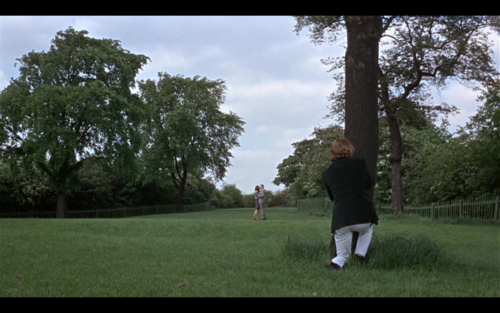
Blow Up (dr. : Michelangelo Antonioni) 1966.
The financial phase of Capitalism reflected the schism in modernist art by mid century. And the growing neurosis of the bourgeoisie. The sense of unreality, of confusion that came from separating the ephemeral from the concrete, was a huge factor in the arts — from Abstract Expressionism to the Theatre of the Absurd. And in film, the most collective of art forms and the one most linked to Capital, it was the secondary and buried anxieties of Western society that were coming to eclipse aspects of even the most commercial products. Antonioni, in hindsight, looms as the chronicler of bourgeois neurosis. Blow Up was the search for that which isn’t there, that which the system of exploitation had removed. What was it that was removed? On the surface (as found in the Cortozar short story on which the screenplay is based) the answer is a murder. In this sense, it resembles Highsmith’s novel Tremor of Intent, Coppola’s The Conversation, and probably a dozen black mask crime novels. But it is echoed in Hitchcock’s Rear Window, as well. And in a perverse way, Strangers on a Train, and I Confess. The Freudian primal scene now looms as the shadow narrative. And the sense of Capital’s lack of concrete representation is now tied in directly with libidinal repression. Antonioni also included scenes referencing Guy Fawkes Day — not arbitrarily to be sure. The trust of that which we cannot see is imprinted from Old Testament writings. Paul on the road to Damascus. Blinded by the light but hearing the voice of Christ. Throughout the King James Bible, old and new testaments, there is a sense of voices without location, and of something very like cinematic reality.
Peter Goodman writes, in a short essay on the film:
“The new economy portrayed in the film is based on style and marketing, not the production of commodities. The worn-out relics of industry have become the target of Thomas’s talent for aestheticizing. Early in the picture, Thomas {the photographer} emerges in disguise from a flophouse where he was surreptitiously taking black & white photographs for his photo book, which will be presumably be a high-brow project establishing his credentials as a serious artist. He photographs the derelicts of working-class life, dispassionately presenting their grotesque bodies as aesthetic spectacle. Nineteenth-century novelistic realism or Italian neo-realism would have represented the lives of such people sympathetically and in-depth, as the victims of industrialization. For postmodernity, industry is somehow not as “real” as marketing, the aesthetic “value-added” that makes the difference between success and failure in an economy which has largely solved the problem of production.”
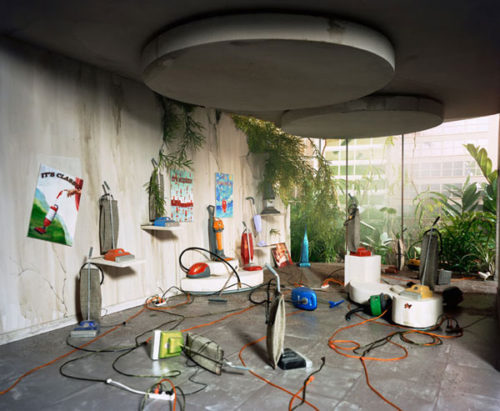
Lori Nix
The Horkheimer and Adorno riff on sacrifice is germane here, too.
“The level of mythology at which the self appears as sacrifice to itself is an
expression not so much of the original conception of popular religion, but
the inclusion of myth in civilization. In the history of class conflict, the
enmity of the self to sacrifice implied a sacrifice of the self, inasmuch as it
was paid for by a denial of nature in man for the sake of domination over
non-human nature and over other men. This very denial, the nucleus of all
civilizing rationality, is the germ cell of a proliferating mythic irrationality:
with the denial of nature in man not merely the telos of the outward control
of nature but the telos of man’s own life is distorted and befogged…”
But narrative in Hollywood no longer operates this way. It is anti narrative in a sense. The 19th century novel developed as monopoly Capitalism and colonialism developed. The consumer, a member of a market, was becoming defined by purchasing power. The observer, the tracker of market trends, the detective in a search for financial clues. The Hollywood film of today is almost post financial capital. It is the story of the commodity viewing the viewer. And perhaps this is the secret of a surveillance state. The ostensive viewer is really being viewed viewing. Stories almost do not exist today without recourse to closed circuit camera footage. The trope of facial recognition is one that *identifies* subjects, who are otherwise without identity. The photographer in Blow Up is looking for something, and an aspect of that is an identity. Today the public is like that which was removed in the park of Blow Up, a predictive effect of algorithms, a subject waiting to materialize. And there is the linkage with guilt. To materialize is to be accused, somehow.
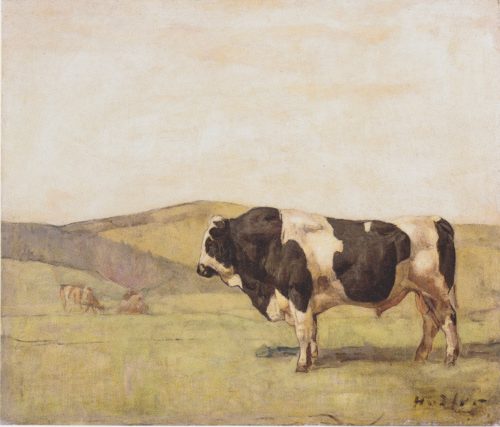
Ferdinand Hodler
Skoll quotes Franco Moretti…
“It is, therefore, completely logical that stream of consciousness is eminently
paratactic: the absence of internal order and of hierarchies indicates its
reproduction of a form of consciousness which is subjugated to the principle
of the equivalence of commodities. It indicates that use-values—the concrete
qualities of any given commodity—are by now perceived as secondary. . . .
What is left to fire the imagination and inflame desire is only the overall
attraction of the chaotic and unattainable collection of commodities…”
The post modern elimination of liberation as something of material realness was the product, in the end, of corporate and ruling class interests emphasizing the abstraction quality of identity as the real. But by also substituting a pre-made self as stand in for self in general. The shopper-man, homo-praestino perhaps. My latin is almost non existant. But this subject position was one that needed constant updating. The white self, that which unconsciously *knows* that Castro was helping liberate Africa, a former colonial holding of Europe, of white Europe, must demean and stigmatize. Today the bourgeoisie in the U.S. is in the midst of a collective nervous breakdown.
“Just as a part of every analysand fears analysis and resists it, mature adults in contemporary societies fear losing the securities of hierarchical
control. It is safer to keep things as they are. It is safer not to know how elites control people to extract wealth. It is safer not to take responsibility
for their own lives but to hand it over to someone else whom they can blame if things go wrong….{ } The analogy between psychoanalytically defined repression and societal level political repression is not just simile or metaphor. Despite psychoanalytic concentration on the personal and psychological, much, if not all, psychological repression finds reinforcement—and often even its origins—in massive, orchestrated social, cultural, and political repression..”
Geoffrey Skoll
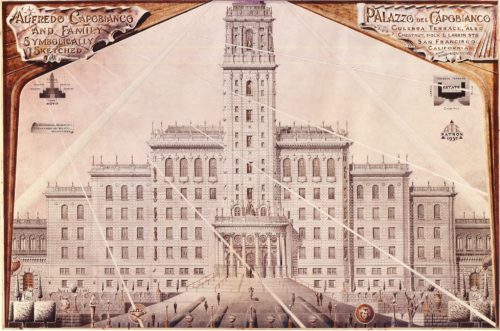
Achilles Gildo Rizzoli
This is a crucial aspect of understanding today’s cultural meltdown. The end of modernism, which for the sake of discussion can be said to coincide with the social upheaval of the sixties, has ushered in the post humaness of today. One of Skoll’s most brilliant observations is that social control is about repression. Psychological repression and political repression are inseparable. They are interdependent. Micro systems of enforcement reflect larger, even global, systems of enforcement. Today, the micro systems of coercion are mostly invisible to the average American (and European, really). And this leads Skoll to the very perceptive observation that the post modern critique of Hardt and Negri serves as counter revolutionary. This is also the failure of more obvious counter revolutionaries like Zizek. When the oppressor exists nowhere, there is nothing to revolt against. Which is why so much post structuralist thought instinctively supports globalization. Why the educated bourgeoisie are appalled at the Brexit vote. Why so few applaud the legacy and achievements of the Cuban Revolution.
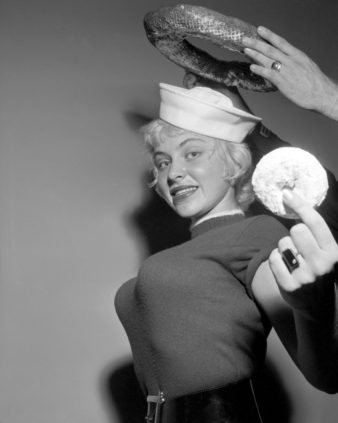
*Donut Queen*, photographer unknown. 1950s.
But to return to the idea of culture, today. Hollywood produces a never ending non stop stream of reactionary police state apologia. But none of it is convincing, but that doesn’t matter. It doesn’t matter because narrative and art in general is no longer grasped or engaged with as it was only fifty or sixty years ago. Much as Obama represented a black man as manufactured by the Cosby Show (per Skol) the new gay rights movement is subsumed by TV and film to help with reinforcing a hierarchy of social status that leaves whiteness at the top. Civil rights was absorbed by Obama, as queer rebellion was absorbed by TV characters who comply with the status quo but happen to be gay — everything is now a reflection of simulacra.
“Discourses about race in the United States are not just the products
of structuring influences and regulatory technologies. They are produced
in the representations and logic of commonsense racial knowledge
constituted in media such as television news and entertainment.
Law and legal discourse is crucial as a subject of media representation.
The dramatic investment in law enforcement and a fascination with
legal discourse are timeless staples of American television. With this
investment, television programs about crime and the criminal justice
system function as a means of establishing the normative legitimacy and
moral propriety of the present legal system no matter how corrupt and
abusive. So, for example, story lines about the lives and antics of the
rich, famous, and corrupt are commonplace, as are narratives about the
arrest and incarceration of black males. Stories about the unbridled
growth of global corporate capital, the increasing concentration of the
ownership structure of the telecommunications industry for example,
are rare. In matters of race and representation, law and legal discourse
are especially crucial because they are the structuring scenes or sites in
which organizing narratives about fairness, civility, propriety, transgression,
and responsibility are framed.”
Herman Gray

Andy Warhol
The frame is always ruling white elite, and even when its not, it is. By which I mean that so pervasive is this dominant frame that all countering frames are just subsumed into the single frame of white rule. The language of Television, today, is one of nearly absolute bourgeois whiteness. It is hard to even notice how uniform and homogenous is the dialogue for 90% of studio product. Subjectivity, the subjectivity of the underclass is non existent. The lower classes, the marginalized figures and the images of decay are always narrated by the ruling class (even when silent). The average American largely goes about his day to day life narrating his own sense of identity and place using this borrowed vocabulary. These are broad statements, and not accurate in their totality, but they represent a growing basic truth; the screen life of the West is white corporate and affluent. And screen reality is more important, holds more authority, than individual experience. The sense of this was part of the prophetic vision of late modernism. The rise of Pop Art was already expressing a sense of this loss of expression — the missing experience, the missing primal scene, the primal murder, was all being erased. In its place stood soup cans. And in a sense, those soup cans of Warhol have come to feel menacing and malignant. Warhol was not just displaying the commodity, he was doing something akin to a reverse Xray. The sense of the viewer being viewed congealed in the best work that came of Pop. There was a deep sense of social anxiety in that work. The well known ‘gold Marilyn’ made in 1962, the year of Monroe’s death, looms as something like a Byzantine momenti mori. And this comparison is likely not accidental (I’m sure I read that somewhere, but can’t remember where) because Warhol’s work starts to feel like the post script to Antonioni. The photographer of ‘swinging London’, an empty man in search of relevance (per the opening sequence at the homeless shelter) finds the mystery in the series of photos he takes — where it no longer matters what is there or what isn’t. Fincher’s one really rather good film, Zodiac, is another study of this almost Warholian anti mystery. The identity (!) of the killer ceases to be the point. It is that gnawing sense of unease in contemporary Western society that what you look for can’t be found. And this inability to secure a definition, or to find solutions, is the quantum world that marks the end of something, the end of Newtonian physics. But it is also the rearing of the ugly head of the Death Drive. Advanced Capital is now so thoroughly contaminated with premonitions of apocalypse that it is hard to find one’s way out of it. The detective trope that began with scientific advances in optics, revealing a world of previously unseen details is ending in the culture of surplus details.

Jasper Johns
Warhol would have loved Trump. In fact Trump is a Warhol artwork come to life in some strange reverse osmosis. For the death drive culture of Capital today is also the culture of waste, of refuse, or anality. The late Pop period luxuriated in shit; both as allegory and literally as mock outrage or scandal. Andreas Serrano’s Piss Christ is perhaps the most notable example. But Donald Kuspit was right to note that the sort of post Pop avant garde was reactionary, and self loathing, finally. The debased, or the abject, were not allegory, but simply shit.
“…the avant-garde became reactionary the moment it was completely swallowed up by capitalism — they’re just shamelessly perverse, like the sex-scandal and corrupt politicians and violent and sex-mad movies that American society seems to mass produce. And also, like them, tragicomic: their shit symbolizes the comic tragedy that art has become and the tragic comedy that America has become. To hide behind a symbol is a form of shame, and shame is socializing…”
Donald Kuspit
I should add another quote here, from Kuspit, from the same short essay…
“The advanced work of art has become a luxury item, the artist’s expensive gift to the advanced capitalist, the most esteemed person in our society, all the more so because making money has become an advanced art in the minds of many, suggesting that the wealthy businessman has a creative gift. Thus the divine rights of the rich. The rich capitalist is a god in all but name, and he must be worshipped and appeased with the fruits of art — a form of tribute and homage — who rewards the artist by making him a rich capitalist — deifying him. “
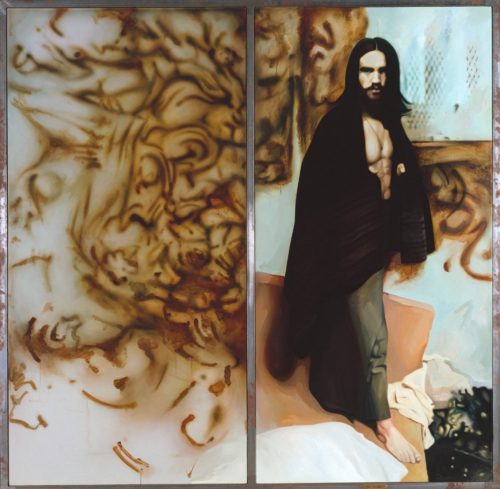
Richard Hamilton
Thus, the gift to the ruling class is one’s own feces. For this is the real allegory of the art market. The psychic strip mining of consumer culture has reached new levels of violence.
“For this is the essential meaning of private secret: that entry
must be invited. Consequently the spaces in which we are
exposed owing to undress, lavatory or sexual functions, the
requirements of quiet or undisturbed activity, tend to be
enclosed, lockable. We may even resist telephone intrusion by
leaving the receiver off. We may browse among a friend’s books
on the shelf but will not look inside his desk. We knock before
entering the closed door of the bath even in our own homes. The
establishment of this boundary of privacy and secrecy is conventional
and if we traverse it unawares we avert the eyes and
hastily retreat with apologies. “
Donald Meltzer
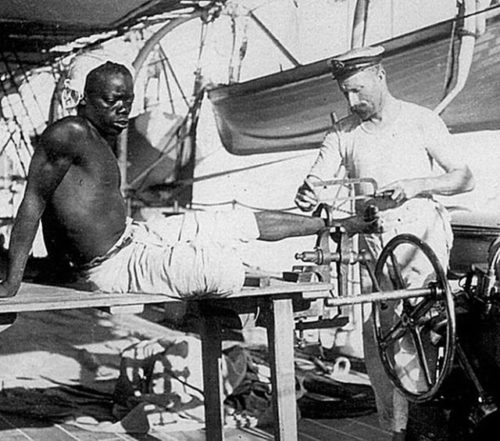
British sailor removing leg irons from slave. Late 1800s.
The search for the missing self, from Antonioni to, perhaps, Warhol, can be traced back to that most prophetic of narraters, Herman Melville. Whether Bartelby or Ahab or Ishmael or Billy Budd, the sense of an impending social violence never leaves. Meltzer suggests that a theory of violence is predicated upon boundaries and secrecy. Violence is violation of the boundaries we create, and socially, at a macro level, this is also what Capital does. The movement of Capital is one (usually) of penetration. The symbolism is difficult to ignore. Nor is it arbitrary. One of the ways individuals manufacture protective screens is through meaningless talk. Pinter was the great explorer of the menace of meaningless conversation. Bion and Klein both wrote of this screening protection in terms of generalized group behavior. One can look at social organizing on the family level and extrapolate from there. Violation is critical to childhood development in the sense that it must be adjusted for. Reich wrote extensively about what he called *character armoring*.
“The social armour that presents as comradery and my-life-is-an-open-book is typical of the politician in our culture, just as the facade of typical-family man
is often the screen for dedicated perversity.”
Donald Meltzer
The assumed authority of institutions, and their political representatives is rarely given much consideration today. This, in one way, is the story of *fake news*. The NY Times, with a long history of proven lies is still the benchmark for authoritative reporting. As Metlzer notes, the display of rank, of uniform, is inherently intrusive. Uniformed police assume and are given a degree of confessional conversation. There is much more to say about all this, and I hope to do so next posting. Bion wrote a good deal about narcissism, and the narcissistic organization of the infantile private body. And more germane perhaps is the topic of degradation. For this is one of the cornerstone realities of contemporary society, I believe. What Meltzer calls the coarsening of ethical values. The age of Trump is really the age of neo liberalism, the age of the death of whiteness. And of patriarchy. Capitalism is death, and itself is dying.
In dreams there is a logic of degradation. The splitting of the self, and this is an important aspect of aesthetics.
“But alertness to the manifestations of aesthetic conflict soon makes one recognize that the most important aspects of the degradation occur in this very dimension: degraded beauty of the objects and degradation.”
Meltzer

Vasudeo Gaitonde
The logic moves from known or identifiable person, to unknown, to inanimate object, to vegetable or mineral, to feces. Degraded beauty is the arena of keenest insight. In a society of hegemonic surveillance, of constant accusation, the shame of the private — both of body and soul, is the real violence of contemporary life. The physical violence of the state is enormous, of course. It is now, at all times, sadistic. But behind even that is a kind of contagion of psychic life. Secrecy is outward directed. Privacy is individual, is the construction of the self. When a society grants authority to the invasion, the penetration of privacy, the result is a loss of capacity for intimacy, a loss of understanding of the boundaries of the self. Shakespeare, the greatest practitioner of the private, is performed today as if he were the author of a DC Comix. Strindberg and Melville are incomprehensible, I think. Dostoyevsky an enigma. Hierarchy itself is sadistic.
“The other reason to fear the empire stems from its role in class war. From
its beginning, capitalism had to gain surplus value from labor. The same
holds true in the twenty-first century. The empire ensures that the supply of
value from labor continues uninterrupted by enforcing labor discipline and
protecting against revolt. The burgeoning of militarized policing, surveillance,
and support of death squads and other terrorists organizations serve in
the global class war at least as much as their employment in imperialist
adventures and aggression.”
Geoffrey Skoll
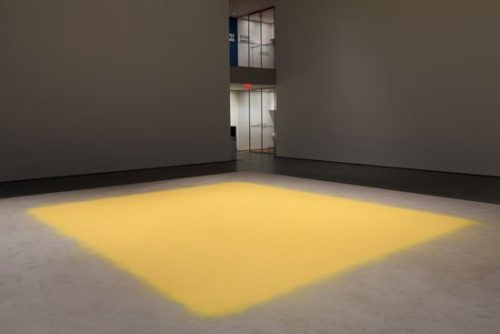
Wolfgang Laib
Trump is a figure that triggers associations with rape. Capitalism is the macro story of rape. If Hillary Clinton was actually the more clearly dangerous political leader, Trump is the better symbol for the end of Capital. The allegory of penetrative capital is already being written and Trump is not even sworn in. The degrading of culture and the intentional and almost aggressive trivializing of art is not insignificant. Any dismissive attitude toward art is revealing of individual pathology, I think. I end with this lengthy quote from Meltzer, taken from a lecture he gave in 1963.
“We are agreed that the successful work of art is compelling; it
induces a process in us, an experience whereby the viewer’s
integration is called upon in the depressive position to restrain
his attacking impulses, for the sake of a good introjection; it
means allowing the good object to make a good kind of
projection into one’s inner world: It requires judgement to
distinguish the good from the bad processes of sadism in the
artist; and masochism in himself, the viewer. I think it follows,
therefore, that the experience of viewing art can be extremely
taxing and extremely hazardous, but that the art-world, as an
institution within our culture, provides a medium for people to
carry out this introjective process in an atmosphere of relative
external safety, corresponding to the safety of the little infant in
the relative restraint of the mother’s arms. When one walks into
an art gallery, one is surrounded by other people and there are
guards and so on; all this constitutes a continual external
support to one’s internal safeguards against attacking the pieces
of art that are exhibited there. Similarly at a concert. It is well
known that, in contrast to this safe viewing of art, at times of
revolution or warfare, pillaging includes a wholesale destruction
of everything of artistic value. There are instances when
people of extremely unbalanced mental state have attacked
priceless works of art in galleries. “

“empty man in search of relevance”
the crisis point of white man that has landed at Trump and the alt-right, not even able to see the irony of them worshiping the very self loathing they claim to be rejecting.
Thanks for the usual great stuff. It’s funny you wrote about Blow Up. I watched it on Saturday and put up similar park stills on the silly facebook. I’m always struck by movies of that era and how different they are from the product of today. The murder being an afterthought, almost a hallucination. The bourgeois anger/violence and desperation for any “authentic” experience to be sold and displayed. Today it would be edited as status and class superiority, maybe some overt message thrown in as well. I’ve never seen the de Palma take but feel like I have to now.
I went to see Arrival last night hoping all those positive reviews would be proven correct but I was confronted instead by just another imperialist film in which the USA stands against the bad Chinese and Russians ready to blow us all up because they don’t get the message and the message is that only the USA understands the language of control handed to them by mysterious creatures from who knows where who want to help mankind-the invader as the Good Samaritan – and the space invaders are of course stand-ins for the USA itself, if only people could understand the message, accept their language, see that their invading forces are not their to harm them but to help them-and the masses-well they are just a violent mob ready to loot and kill at the drop of a ufo, and the black man played by Forrest Whitaker – why is he doing these roles-as step n fetchit-to the white saviours of us all.
I spent a few days in and around the Cleveland museum of art recently. They have the largest endowment after the Getty. Great museum. Free every day. I hadn’t been there in 20 years. What struck me apart from the improvements they’d made was the level of scrutiny I felt- from the guards to the museum staff. High level paranoia bordering on terror seems to be the sensibility of the day. It must be encouraged. It’s like everyone is trapped in their own version of blow up, scrutinizing their fellow men instead of a photo of a park. Cheering.